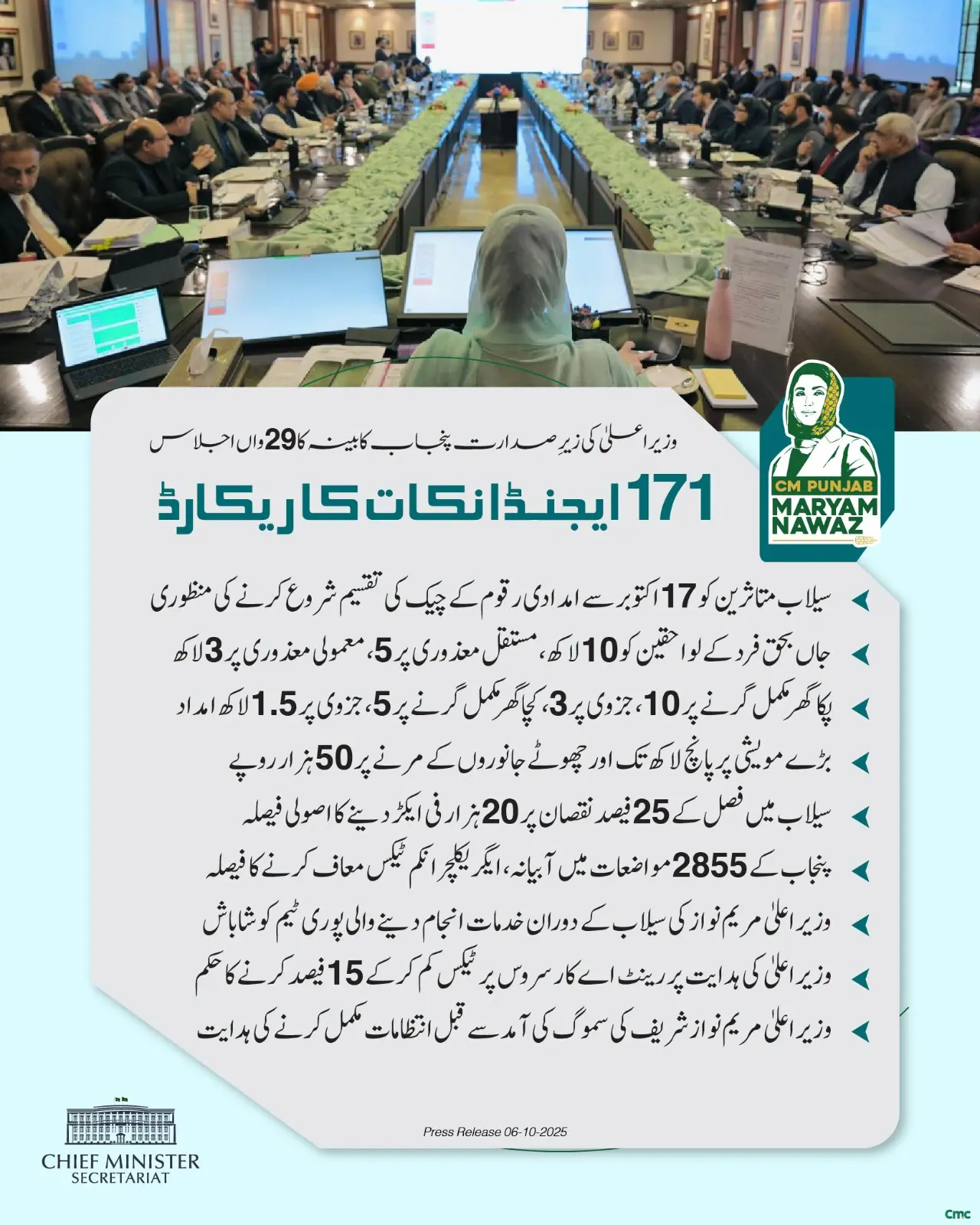The Punjab government has officially approved the Flood Relief Package 2025 under the leadership of Chief Minister Maryam Nawaz Sharif. This major decision was made during the 296th cabinet meeting, where 171 agenda points were discussed. The meeting focused on helping flood-affected families across Punjab and rebuilding damaged areas. The package includes financial support for affected citizens, farmers, and students. It also addresses housing reconstruction, livestock losses, and crop damage.
Introduction to the Flood Relief Package
The Punjab government announced a large-scale relief plan to help people whose homes, crops, or livestock were destroyed in the recent floods. The government will start distributing financial aid and cheques from 17 October 2025. The relief package covers almost every sector affected by the floods, including housing, agriculture, and education.
The main goal of this package is to support families who lost their loved ones or property and to help them rebuild their lives. The government also aims to restore normal life in flood-hit districts through this plan.
Key Approvals from the Cabinet Meeting
During the cabinet meeting, several important points were discussed and approved. The meeting was presided over by CM Maryam Nawaz Sharif, who expressed her commitment to stand by every flood-affected family. Officials from different departments attended the meeting and shared updates on damage reports and recovery plans.
The following are the major decisions approved under the Flood Relief Package 2025.

1. Aid for Families of Deceased Victims
The government decided to give Rs. 10 lakh (1 million) to families who lost a family member during the floods. This payment aims to help them recover from the financial burden caused by the loss. Each family of a deceased person will receive this amount through a transparent verification and cheque distribution system.
The CM stated that no affected family should be left behind and that these funds will reach them directly through district administration teams.
2. Support for Disabled and Injured Persons
Floods left many people injured or disabled. The Punjab government approved compensation for these victims as well:
- Rs. 5 lakh for those who became permanently disabled.
- Rs. 3 lakh for those who suffered partial disability.
- Rs. 1.5 lakh for individuals who were injured during the disaster.
This financial aid will help them afford medical treatment and rebuild their livelihoods. The government has directed health departments to ensure that beneficiaries get their payments without delay.
3. Compensation for Damaged Houses
Thousands of homes were either fully or partially destroyed by floodwater. To support affected homeowners, the following decisions were made:
- Rs. 5 lakh will be given for completely destroyed houses.
- Rs. 1.5 lakh will be provided for partially damaged houses.
These payments will help people repair or rebuild their homes before the winter season. Local authorities will carry out field surveys to verify damages and ensure fair distribution of funds.
4. Financial Help for Livestock Loss
Many families in rural areas lost their animals, which are often their main source of income. Recognizing the importance of livestock in rural livelihoods, the government approved Rs. 50,000 per lost animal.
This decision aims to help farmers buy new animals and restore their income sources. The government also instructed livestock departments to complete surveys quickly and compensate owners fairly.
5. Crop Damage Compensation
Floods destroyed standing crops on thousands of acres. Farmers faced major financial losses. To help them recover, the cabinet approved Rs. 20,000 per acre for those who lost 25% or more of their crops.
This support will help farmers replant and prepare for the next season. The government also directed agricultural officers to identify affected fields through transparent field reports.
6. Fee Waiver for Flood-Affected Students
In addition to financial relief, the government decided to support students from flood-hit areas. Around 2,855 students from Attock, Mianwali, and Bhakkar will receive complete fee waivers for their examinations.
This step ensures that no student’s education is interrupted because of financial hardship. The Punjab Education Department has been instructed to immediately implement this decision and inform all concerned institutions.
7. Recognition for Government Workers
CM Maryam Nawaz Sharif praised all government employees, officers, and volunteers who worked tirelessly during the floods. She appreciated their services and dedication, especially those who stayed on the ground day and night to help affected families.
She also announced that employees who performed outstanding work will receive appreciation certificates and rewards.
8. Pre-Monsoon Preparations Ordered
The Chief Minister directed all departments to complete pre-monsoon arrangements before the next rainy season. She instructed disaster management teams, irrigation departments, and district administrations to prepare early to avoid future losses.
She emphasized that lessons from this year’s flood must guide better planning and quicker response in the future.
9. Transparent Distribution Process
To prevent misuse of funds, the Punjab government will use a transparent verification system for all beneficiaries. Officials will verify losses through field visits and record data digitally. Cheques will be issued after proper confirmation to avoid double payments or errors.
Maryam Nawaz also said that transparency and fairness are the foundation of this relief package.
10. Focus on Rehabilitation and Reconstruction
Besides cash aid, the government will begin a rehabilitation plan to rebuild roads, bridges, schools, and hospitals damaged during the floods. Construction and repair work will be carried out in coordination with local governments and development authorities.
Special attention will be given to remote and underdeveloped areas where people suffered the most damage.
Implementation Schedule
The process of cheque distribution will start from 17 October 2025. Teams have been formed at the district level to manage this work. Each team will visit flood-affected villages, verify beneficiaries, and issue cheques on-site.
A digital dashboard will track the entire process to ensure that funds reach the right people without delays.
Relief Categories at a Glance
| Relief Category | Compensation Amount (Rs.) |
|---|---|
| Death of a family member | 1,000,000 (10 lakh) |
| Permanent disability | 500,000 (5 lakh) |
| Partial disability | 300,000 (3 lakh) |
| Injury during floods | 150,000 (1.5 lakh) |
| Completely destroyed house | 500,000 (5 lakh) |
| Partially damaged house | 150,000 (1.5 lakh) |
| Lost livestock (per animal) | 50,000 |
| Crop loss (25% or more damage) | 20,000 per acre |
| Fee waiver for students | Full exemption for 2,855 students |
Maryam Nawaz’s Statement
During the meeting, CM Maryam Nawaz said that this relief package is a promise fulfilled to the people of Punjab. She added that her government will not rest until every flood-affected family is back on their feet.
She also highlighted the importance of fair and quick distribution, saying that justice and transparency are key to restoring public trust. Her instructions to officials were clear: every rupee must reach the right person.
Cabinet’s Vision Behind the Package
The flood relief package is not just about money. It reflects the government’s long-term vision of creating a secure and responsive disaster management system in Punjab.
The cabinet aims to strengthen the infrastructure, improve emergency response, and train local administrations to handle natural disasters efficiently.
The CM also stressed that early warning systems and local coordination must be improved to save lives in future floods.
Impact on Rural Communities
This package will directly benefit thousands of rural families who depend on agriculture and livestock for their income. By compensating their losses, the government is helping them restart farming and rebuild homes.
The decision also sends a strong message that the government values the struggles of ordinary citizens and stands with them during hard times.
Public Response
People across Punjab welcomed the decision. Many affected families expressed relief that the government took quick action. Farmers’ associations also appreciated the Rs. 20,000 per acre compensation, calling it a timely step before the next sowing season.
Education activists praised the fee waiver decision for flood-affected students, saying it would help them continue their studies without financial stress.
Monitoring and Accountability
To make sure funds are used properly, the Chief Minister has formed special monitoring teams. These teams will visit districts, check progress reports, and submit updates directly to the CM Office.
A complaint system will also be introduced for citizens to report delays or irregularities. The goal is to make the entire process smooth, transparent, and fair.
Future Planning
CM Maryam Nawaz directed the administration to prepare a comprehensive flood prevention strategy for the coming years. She advised upgrading drainage systems, strengthening embankments, and clearing waterways before heavy rains begin.
She also mentioned that climate change is increasing the risk of floods, so the province needs better infrastructure and community awareness to face such challenges.
Conclusion
The CM Punjab Flood Relief Package 2025 is a historic decision by the Punjab government. It reflects strong leadership, compassion, and a clear commitment to public welfare. The package covers every major loss faced by citizens, from deaths and disabilities to home destruction and crop damage.
By providing financial aid and planning for future safety, the government aims to rebuild lives and restore hope in the flood-hit communities of Punjab.

